2. 陕西乾县农业技术推广站,陕西乾县 713300
2. Qian County Agricultural Technology Extension Station of Shaanxi Province, Qianxian, Shaanxi 713300, China
由于人口不断增加和经济快速发展,导致粮食消耗量和需求量持续增长,保证粮食作物可持续增产成为全球面临的重大问题之一[1–2]。旱地约占全球陆地面积的 40%,养育着 40% 的世界人口[3],旱地农业对保证全球粮食安全有重要意义。地膜覆盖是旱地广泛使用的地表覆盖方式,它能够减少水分蒸发、改善地面温度,进而提高作物产量[4–5]。大量文献报道了地膜覆盖的增产效应,Charkraborty 等[6]和 Gao 等[7]研究表明在冬小麦生育期覆盖地膜分别增产 12% 和 21%。地膜覆盖也能改变作物的养分吸收能力。Yuan 等[8]在水稻生育期覆盖地膜使其地上部吸氮量增加 27%。Iqbal 等[9]在冬小麦生育期覆盖地膜使其地上部吸氮量也增加 10%。然而,陈小莉等[10]却发现在春玉米生育期覆盖地膜对地上部吸氮量无影响。此外,秸秆覆盖也能减少地表水分蒸发,增加土壤贮水量,提高作物产量。Devkota 等[11]证实秸秆覆盖使小麦产量增加 5%,玉米产量增加 10%。秸秆还田也会影响作物的养分吸收。在氮肥用量为 325 kg/hm2 时,玉米秸秆还田使下季小麦吸氮量增加 7%[12];而在氮肥用量为 120 kg/hm2 时,水稻秸秆还田使下季小麦吸氮量减少 9%[13];同时,休闲期覆盖促进了小麦植株对氮素的吸收和积累,增加了花后氮素积累量以及籽粒氮素积累量,提高了氮素收获指数和氮素生产效率[14];但也有研究表明,全程地膜覆盖并没有使春小麦和冬小麦产量、吸氮量和氮效率大幅度提高[15]。综上所述,不同地表覆盖方式调控作物产量、养分吸收量的效果不同,且相同地表覆盖的作物产量形成和养分利用因地点而异。
西北地区特殊的生态环境,水肥管理与保水栽培一直是研究的重点。但目前多集中于产量和水分利用效率的研究,养分效率以及养分吸收后形成小麦籽粒产量和养分含量能力的报道相对较少。为此本试验在陕西省永寿县御驾宫村黄土高原渭北旱地冬小麦种植区布置 4 年田间定位试验,旨在研究旱地氮肥用量、地表覆盖对旱地冬小麦产量、氮磷钾需求及生理效率的影响,为旱地小麦增产增效和优质生产提供依据。
1 材料与方法 1.1 试验地概况试验地位于黄土高原典型旱作雨养农业区陕西省永寿县御驾宫村,东经 35.7°,北纬 108.2°,海拔 995 m。该区属暖温带半湿润大陆性气候,年均气温在 10.8℃ 左右,年平均降雨量为 601.6 mm 左右,主要集中在 7~9 月份。潜在蒸发量为 807.4 mm,0—20 cm 耕层土壤 pH 为 8.1,有机质平均含量为 11.7 g/kg,全氮 0.87 g/kg,硝态氮 14.5 mg/kg,铵态氮 2.7 mg/kg,有效磷 10.7 mg/kg,速效钾 99.9 mg/kg,容重为 1.25 g/cm3。试验于 2012 年 9 月到 2016 年 6 月进行,共 4 季。2012~2013、2013~2014、2014~2015 和 2015~2016 年的年降水量分别为 415、545、631 和 414 mm。根据 Sun 等[16]的降水分类方法及当地长期的降水资料 (1957~2014 年),年降水量 > 671 mm 为丰水年,年降水量 < 492 mm 为欠水年,年降水量介于二者之间为平水年,故 2012~2013 和 2015~2016 年属欠水年,2013~2014 和 2014~2015 年属平水年。
1.2 试验设计试验以不施氮肥为对照,设施氮肥 195 kg/hm2 (N1 农户模式)、150 kg/hm2 (N2 农户减氮),及垄覆沟播 (RMFS),全膜穴播 (FMHS) 和秸秆覆盖 (SMHS),共 6 个处理,两个氮肥处理为常规平作,行宽 20 cm,无覆盖。3 个覆盖处理施氮量均为 150 kg/hm2。垄覆沟播:垄上覆膜,沟内覆秸秆,播种在沟内,垄沟比 30 cm∶30 cm,覆秸秆量为 2250 kg/hm2 (干重)。全膜穴播:地表全部用地膜覆盖,进行点播种植,株距 12 cm,每穴播 10 粒。秸秆覆盖:覆秸秆量 10000 kg/hm2 (干重),全覆盖。垄覆沟播、全膜穴播和秸秆覆盖在休闲期保持相应的地表覆盖,在播种前去除地表覆盖,待播种后再重新覆盖。全膜穴播和秸秆覆盖处理夏闲期免耕,其他处理均三伏天深耕 1 次,播前 7 天旋耕 1 次。试验采用完全随机区组设计,重复 4 次,小区面积 48 m2 (12 m × 4 m),小麦品种为运旱 20410。冬小麦生育期间无任何补充灌溉,人工控制杂草,不施入任何除草剂,且无明显病虫害发生。氮磷肥均作为底肥使用,氮肥用尿素 (氮含量 46%),磷肥用过磷酸钙 (P2O5 含量 12%),两种肥料在小麦播种前均匀撒入小区,翻入土壤耕层后耙平。
1.3 样品采集与测定1.3.1 样品采集 小麦收获期采集植物样品,每个小区中间选取 3 m2 样方,小麦植株连根拔起,于根茎结合处剪掉根系后,将小麦分为穗和茎叶风干后,再将穗分为籽粒和颖壳,然后称量籽粒、颖壳和茎叶风干重。取 100 g 籽粒、50 g 颖壳和 50 g 茎叶烘干后作为化学分析样品。
1.3.2 样品测定 植物样品 (籽粒、颖壳和茎叶) 烘干粉碎后用 H2SO4–H2O2 法消解,用连续流动分析仪 (Auto analysis 3) 测定消解液的氮和磷素,用火焰光度计测定消解液的钾素。
1.4 数据计算1.4.1 地上部氮 (磷、钾) 吸收量 地上部氮 (磷、钾) 吸收量是指作物在整个生育期地上部吸收的氮 (磷、钾) 量,反映作物从土壤携出养分能力。计算公式:
地上部氮 (磷、钾) 吸收量 (kg/hm2) = [籽粒含氮 (磷、钾) 含量 × 籽粒产量 + 茎叶氮 (磷、钾) 含量 × 茎叶生物量 + 颖壳氮 (磷、钾) 含量 × 颖壳生物量]/1000。
1.4.2 籽粒产量形成的养分需求量、养分生理效率 籽粒产量形成的养分需求量,指小麦生产 100 kg 籽粒产量需要的地上部养分吸收量,反映作物形成籽粒产量对养分的需求情况。计算公式如下:
百公斤籽粒氮 (磷、钾) 需求量 (kg/kg) = 地上部吸氮 (磷、钾) 量/产量 × 100。
籽粒产量形成的养分生理效率,指地上部吸收单位养分所能生产的籽粒产量,反映作物利用吸收的养分形成籽粒产量的能力。计算公式:
籽粒产量形成的氮 (磷、钾) 生理效率 (kg/kg) = 产量/地上部吸氮 (磷、钾) 量。
1.5 数据处理试验数据均用 Excel 和 SPSS 数据处理统计软件进行分析。
2 结果 2.1 冬小麦籽粒产量和生物量由表 1 可知,减氮处理产量与常规氮肥处理在 4 年均无显著差异。在施氮 150 kg/hm2 条件下,与不覆盖相比,垄覆沟播的产量在 2012~2013 欠水年显著增产 15.7%;全膜穴播在 2013~2014 和 2014~2015 年两个平水年和 2012~2013 欠水年分别显著增产 7.8%、15.2% 和 18.5%;秸秆覆盖的产量在 2014~2015 平水年和 2012~2013 欠水年分别显著增产 9.0% 和 19.9%。但垄覆沟播和秸秆覆盖 4 年平均产量相比无覆盖无显著差异,而全膜穴播显著增产 6.8%。
| 表1 不同处理冬小麦籽粒产量和生物量 (kg/hm2) Table 1 Effects of different treatments on grain yields and biomass of winter wheat |
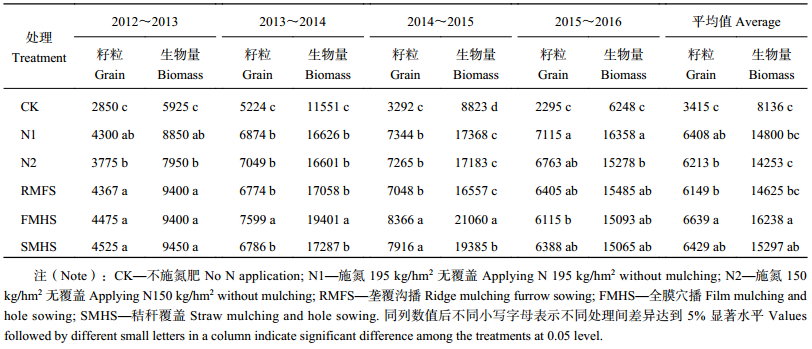 |
不同处理对冬小麦生物量的影响在不同年际间不同。在无覆盖条件下,减氮的小麦生物量比常规施氮在 2015~2016 欠水年显著减少 6.6%。在 150 kg/hm2 的施氮条件下,与无覆盖相比,垄覆沟播的生物量在 2012~2013 欠水年显著增加 18.2%;全膜穴播的生物量在 2013~2014 和 2014~2015 年两个平水年和 2012~2013 欠水年分别显著增加 16.9%、22.6% 和 18.2%;秸秆覆盖的生物量在 2014~2015 平水年和 2012~2013 欠水年分别显著增加 12.8% 和 18.9%。全膜穴播和秸秆覆盖 4 年平均生物量分别比减氮无覆盖显著增加 13.9% 和 7.3%。
2.2 籽粒和秸秆养分吸收量2.2.1 籽粒和秸秆吸氮量 比较籽粒吸氮量,发现在不同氮肥水平下,农户减氮的籽粒吸氮量与农户模式相比在各年份均无显著差异 (表 2)。在 150 kg/hm2 的施氮条件下,与农户减氮相比,秸秆覆盖的籽粒吸氮量在 2014~2015 平水年显著增加 17.3%;垄覆沟播、全膜穴播和秸秆覆盖在 2015~2016 欠水年分别显著减少 13.9%、19.9% 和 9.5%。秸秆覆盖 4 年平均籽粒吸氮量相比农户减氮处理显著增加 3.7%。
| 表2 不同处理的冬小麦籽粒和秸秆吸氮量 (kg/hm2) Table 2 Grain and straw N uptakes of winter wheat under different treatments |
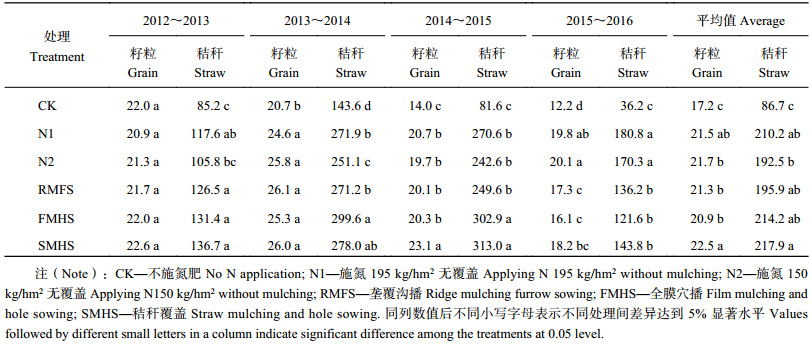 |
秸秆吸氮量结果表明 (表2),在不同氮肥水平下,农户减氮的秸秆吸氮量相比农户模式在 2013~2014 平水年显著减少 7.6%。在 150 kg/hm2 的施氮条件下,与农户减氮相比,垄覆沟播的秸秆吸氮量在 2012~2013 欠水年和 2013~2014 平水年分别显著增加 19.6% 和 8.0%,而在 2015~2016 欠水年显著减少 20.0%;全膜穴播在 2013~2014 和 2014~2015 年两个平水年和 2012~2013 欠水年分别显著增加 19.3%、24.9% 和 24.2%,而在 2015~2016 欠水年显著减少 28.6%;秸秆覆盖在 2013~2014 和 2014~2015 年两个平水年和 2012~2013 欠水年分别显著增加 10.7%、29.0% 和 29.2%,而在 2015~2016 欠水年显著减少 15.6%。秸秆覆盖 4 年平均秸秆吸氮量相比农户减氮显著增加 13.2%。
2.2.2 籽粒和秸秆吸磷量 不同覆盖措施能够改变冬小麦的籽粒吸磷量,在不同氮肥水平下,农户减氮的籽粒吸磷量相比农户模式在各年份均无显著差异 (表 3)。在 150 kg/hm2 的施氮条件下,与农户减氮相比,垄覆沟播的籽粒吸磷量在 2013~2014 平水年显著增加 6.7%;全膜穴播和秸秆覆盖的籽粒吸磷量各年份均无显著差异。
| 表3 不同处理的冬小麦籽粒和秸秆吸磷量 (kg/hm2) Table 3 Grain and straw P uptakes of winter wheat under different treatments |
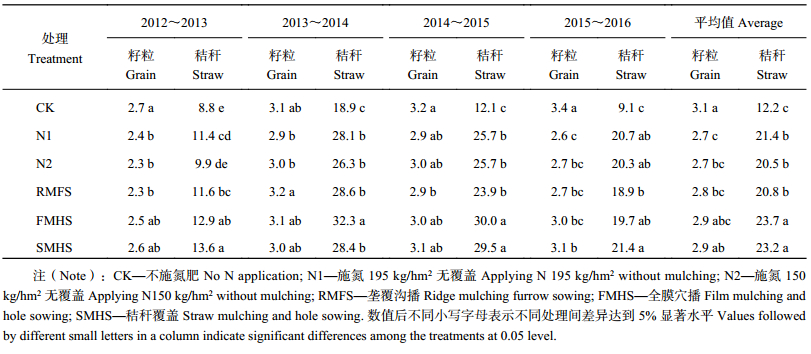 |
分析秸秆吸磷量,发现在不同氮肥水平下,农户减氮的秸秆吸磷量相比农户模式在各年份均无显著差异。在 150 kg/hm2 的施氮条件下,与无覆盖相比,垄覆沟播的秸秆吸磷量在 2012~2013 欠水年显著增加 17.2%;全膜穴播在 2013~2014 和 2014~2015 年两个平水年和 2012~2013 欠水年分别显著增加 22.8%、16.7% 和 30.3%;秸秆覆盖在 2012~2013 欠水年和 2014~2015 平水年分别显著增加 37.4% 和 14.8%。全膜穴播和秸秆覆盖 4 年平均秸秆吸磷量分别比农户减氮无覆盖显著增加 15.6% 和 13.2%。
2.2.3 籽粒和秸秆吸钾量 在不同氮肥水平下,农户减氮的籽粒吸钾量相比农户模式在各年份均无显著差异 (表 4)。在 150 kg/hm2 的施氮条件下,与农户减氮无覆盖相比,各覆盖处理均无显著差异。分析秸秆吸钾量可知,在 150 kg/hm2 的施氮条件下,与无覆盖相比,全膜穴播在 2013~2014 和 2014~2015 年两个平水年分别显著增加 28.5% 和 32.4%;秸秆覆盖在 2013~2014 和 2014~2015 年两个平水年和 2012~2013 欠水年分别显著增加 27.7%、31.7% 和 27.0%。全膜穴播和秸秆覆盖 4 年平均秸秆吸钾量比农户减氮无覆盖处理分别显著增加 23.4% 和 24.4%。
| 表4 不同处理的冬小麦籽粒和秸秆吸钾量 (kg/hm2) Table 4 Grain and straw K uptakes of winter wheat under different treatments |
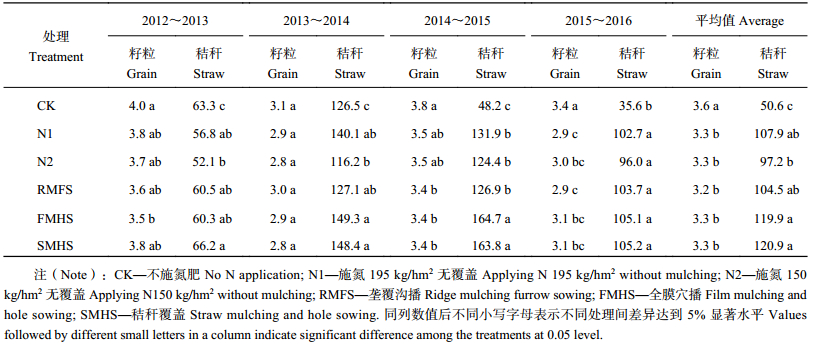 |
2.3.1 小麦百公斤籽粒氮磷钾养分需求量 分析百公斤籽粒需氮量表明,在不同氮肥水平下,农户减氮的籽粒需氮量相比农户模式仅在 2014~2015 平水年减少 9.5%(表 5)。在 150 kg/hm2 的施氮条件下,与农户减氮相比,垄覆沟播在 2013~2014 平水年显著增加 12.6%,而在 2015~2016 欠水年显著减少 15.9%;全膜穴播仅在 2015~2016 欠水年显著减少 21.4%;秸秆覆盖在 2013~2014 和 2014~2015 年两个平水年分别显著增加 14.9% 和 18.9%,而在 2015~2016 欠水年显著减少 11.1%。垄覆沟播、全膜穴播和秸秆覆盖 4 年平均需氮量相比农户减氮分别显著增加 2.6%、2.0% 和 8.5%。
| 表5 不同处理对冬小麦百公斤籽粒产量形成氮磷钾养分需求量的影响 (kg/100 kg) Table 5 Nutrient requirements for 100 kg grain of winter wheat under different treatments |
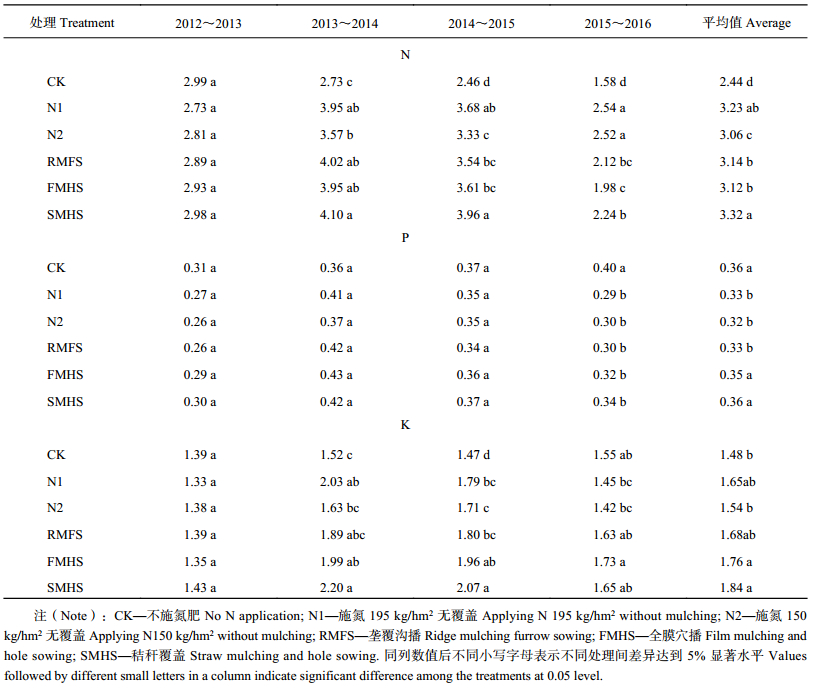 |
分析百公斤籽粒需磷量可知,在不同氮肥水平下,农户减氮的籽粒需磷量相比农户模式在各年份均无显著差异。在 150 kg/hm2 的施氮条件下,与农户减氮相比,垄覆沟播、全膜穴播和秸秆覆盖在 2013~2014 平水年分别显著增加 13.5%、16.2% 和 13.5%。全膜穴播和秸秆覆盖 4 年平均籽粒需磷量分别比农户减氮显著增加 9.4% 和 12.5%。
分析百公斤籽粒需钾量可知,在不同氮肥水平下,农户减氮的籽粒需钾量相比农户模式在各年份均无显著差异。在 150 kg/hm2 的施氮条件下,与农户减氮相比,全膜穴播在 2014~2015 平水年和 2015~2016 欠水年分别显著增加 14.6% 和 21.8%;秸秆覆盖在 2013~2014 和 2014~2015 年两个平水年和 2015~2016 欠水年分别显著增加 34.9%、21.1% 和 16.2%。秸秆覆盖 4 年平均籽粒需钾量相比农户减氮显著增加 19.5%。
2.3.2 小麦籽粒产量形成的养分生理效率 分析籽粒产量形成的氮生理效率可知,在不同氮肥水平下,农户减氮的氮生理效率相比农户模式在各年份均无显著差异 (表 6)。在 150 kg/hm2 的施氮条件下,与农户减氮相比,全膜穴播的氮生理效率仅在 2015~2016 欠水年显著增加 27.3%;秸秆覆盖在 2015~2016 欠水年显著增加 12.0%,而在 2014~2015 平水年显著减少 16%。相比农户减氮 4 年平均氮生理效率,各处理之间均无显著差异。
| 表6 不同处理冬小麦籽粒产量形成氮磷钾的生理效率 (kg/kg) Table 6 Physiological efficiencies for grain yield formation of N, P and K under different treatments |
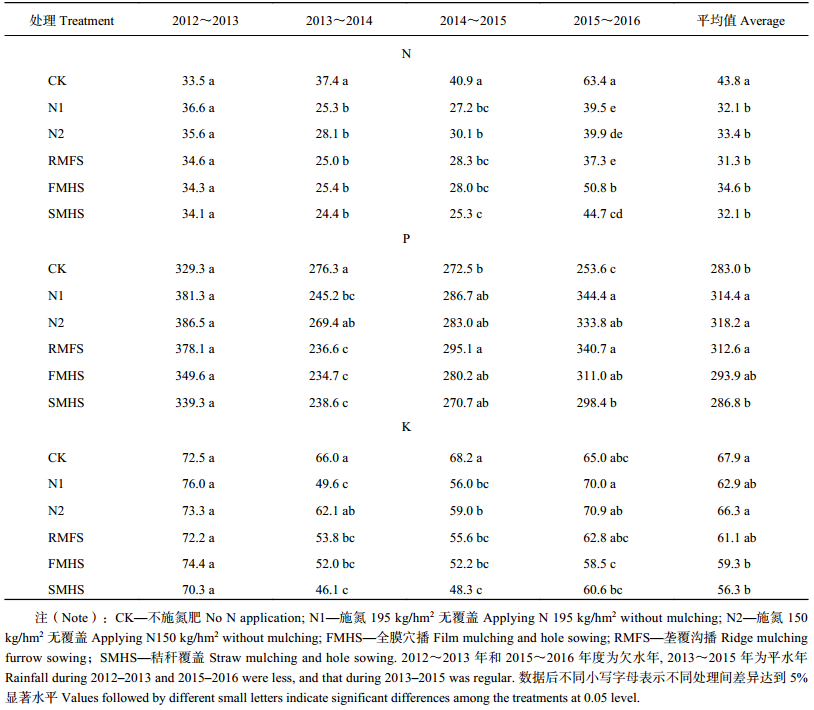 |
比较籽粒产量形成的磷生理效率发现,在不同氮肥水平下,农户减氮的磷生理效率相比农户模式在各年份均无显著差异。在 150 kg/hm2 的施氮条件下,与农户减氮相比,垄覆沟播、全膜穴播和秸秆覆盖在 2013~2014 平水年分别显著减少 12.2%、12.9% 和 11.4%。秸秆覆盖 4 年平均磷生理效率相比农户减氮显著减少 9.9%。
籽粒产量形成的钾生理效率分析表明,在不同氮肥水平下,农户减氮的钾生理效率相比农户模式在 2013~2014 平水年显著增加 25.2%。在 150 kg/hm2 的施氮条件下,与农户减氮相比,全膜穴播仅在 2015~2016 欠水年显著减少 17.5%;秸秆覆盖在 2013~2014 和 2014~2015 两个平水年分别显著减少 25.8% 和 18.1%。全膜穴播和秸秆覆盖 4 年平均钾生理效率相比农户减氮分别显著减少 10.6% 和 15.1%。
3 讨论 3.1 不同覆盖措施对冬小麦籽粒产量和籽粒养分含量的影响地膜覆盖能够减少土壤水分蒸发,改善土壤水分环境,促进小麦个体发育和群体构建,提高作物体内干物质积累及干物质向籽粒的转运能力,从而增加作物产量[17–18]。Rehman 等[19]在小麦生育期覆盖地膜增产 5%,Li 等[20]在春小麦生育期覆盖地膜增产 23%。本试验垄覆沟播在 2012~2013 年显著增产 15.7%,全膜穴播显著增产 6.8%,与上述研究结果一致。另有研究表明,休闲期降雨量与小麦产量呈正相关,小麦一半以上的产量取决于播种前底墒的好坏[21]。小麦产量出现年际变化, 可能与休闲期降水形成的底墒量有关[22]。本试验在 2012~2013 年 7~9 月休闲期降雨量为 301 mm,2014~2015 年休闲期降雨量为 318 mm,且全年降雨量较多,秸秆覆盖处理产量显著增加,与上述结果一致。因此,地膜覆盖有利于提高冬小麦产量,秸秆覆盖在降雨较多的年份增加冬小麦产量。
地表覆盖实现了旱地冬小麦增产,但籽粒含氮量却明显下降,这可能是由于地膜覆盖降低了小麦花期土壤硝态氮含量,导致花后土壤供氮不足,进而降低了籽粒含氮量[23]。Ram 等[24]也表明秸秆覆盖使小麦籽粒含氮量降低是由于土壤矿质氮含量降低引起的。本研究秸秆覆盖的籽粒吸氮量在 2015~2016 年显著减少 9.5%,这可能与秸秆覆盖引起土壤氮生物固持有关[25]。
关于地表覆盖对小麦籽粒磷钾含量影响的报道较少。本试验地表覆盖能改变籽粒含磷量和籽粒含钾量。小麦籽粒含钾量与土壤钾含量有直接关系[26],地表覆盖通过改变土壤养分供应能力及作物养分吸收能力对籽粒养分含量产生影响,地表覆盖在不同降水年型间的籽粒养分效应差异,主要是由于土壤水分和养分等环境因素改变作物生长发育进程而引起的。
3.2 不同覆盖措施对冬小麦籽粒产量形成的养分需求量和生理效率的影响地表覆盖影响籽粒产量形成的需氮量和氮生理效率,主要是由于籽粒产量和地上部吸氮量不均衡增加造成的[26]。土壤水分供应不足是旱地作物生产的主要限制因素。全膜穴播改善土壤水分状况,增加籽粒产量,同时增加秸秆吸氮量,而籽粒产量形成的需氮量和氮生理效率未增加;垄覆沟播的产量未增加,而秸秆吸氮量增加,从而提高了籽粒产量形成的需氮量、降低了籽粒产量形成的氮生理效率;秸秆覆盖的产量、秸秆吸氮量增加,而籽粒产量形成的需氮量也增加,从而降低了籽粒产量形成的氮生理效率。
以往关于地表覆盖对籽粒产量形成的磷、钾需求量和磷、钾生理效率的报道较少,大部分集中在施磷、钾肥以及区域间土壤肥力差异带来的作物磷、钾效应差异。串丽敏等[27]总结 2000~2011 年全国小麦试验研究资料,得出百公斤籽粒产量形成需磷量为 0.6 kg,高于本试验的 0.3 kg;籽粒产量形成的磷生理效率为 189.5 kg/kg,低于本试验的 301.5 kg/kg。这主要是因为黄土高原的土壤是碱性土,土壤有效磷活性低,降低了小麦对磷的吸收效率,从而减少了形成单位籽粒产量所需的磷素、增加了小麦吸收单位磷素形成籽粒产量的能力。Chuan 等[28]还总结出百公斤籽粒需钾量为 1.9 kg,高于本试验的 1.66 kg;籽粒钾生理效率为 52.7 kg/kg,低于本试验的 62.3 kg/kg。
4 结论农户减氮模式对冬小麦的产量、氮磷钾需求量以及生理效率无显著影响。垄覆沟播处理的产量未增加,而秸秆吸氮量增加,从而提高了籽粒产量形成的需氮量、降低了籽粒产量形成的氮生理效率。全膜穴播提高籽粒产量,同时增加秸秆吸氮量,但未增加籽粒产量形成的需氮量和氮生理效率。秸秆覆盖的产量增加,同时增加秸秆吸氮量,而籽粒产量形成的需氮量也增加,从而降低了籽粒产量形成的氮生理效率。因此,旱地小麦生产中为保证籽粒产量,需增加地膜覆盖和秸秆覆盖的氮肥用量。
| [1] | Godfray H C J, Beddington J R, Crute I R, et al. Food security: The challenge of feeding 9 billion people[J]. Science, 2010, 327: 812–818. DOI:10.1126/science.1185383 |
| [2] | Barrett C B. Measuring food insecurity[J]. Science, 2010, 327: 825–828. DOI:10.1126/science.1182768 |
| [3] | Stewart B A, Liang W L. Strategies for increasing the capture, storage, and utilization of precipitation in semiarid regions[J]. Journal of Integrative Agriculture, 2015, 14(8): 1500–1510. DOI:10.1016/S2095-3119(15)61096-6 |
| [4] | Li F M, Song Q H, Jjemba P K, Shi Y C. Dynamics of soil microbial biomass C and soil fertility in cropland mulched with plastic, film in a semiarid agro-ecosystem[J]. Soil Biology and Biochemistry, 2004, 36(11): 1893–1902. DOI:10.1016/j.soilbio.2004.04.040 |
| [5] | Zhou L M, Li F M, Jin S L, Song Y J. How two ridges and the furrow mulched with plastic film affect soil water, soil temperature and yield of maize on the semiarid Loess Plateau of China[J]. Field Crops Research, 2009, 113(1): 41–47. DOI:10.1016/j.fcr.2009.04.005 |
| [6] | Chakraborty D, Nagarajan S, Aggarwal P, et al. Effect of mulching on soil and plant water status, and the growth and yield of wheat (Triticum aestivum L.) in a semi-arid environment [J]. Agricultural Water Management, 2008, 95(12): 1323–1334. DOI:10.1016/j.agwat.2008.06.001 |
| [7] | Gao Y J, Li Y, Zhang J C. Effects of mulch, N fertilizer, and plant density on wheat yield, wheat nitrogen uptake, and residual soil nitrate in a dry land area of China[J]. Nutrient Cycling in Agroecosystems, 2009, 85(2): 109–121. DOI:10.1007/s10705-009-9252-0 |
| [8] | Yuan L, Zhang Z C, Cao X C, et al. Responses of rice production, milled rice quality and soil properties to various nitrogen inputs and rice straw incorporation under continuous plastic film mulching cultivation[J]. Field Crops Research, 2014, 155: 164–171. DOI:10.1016/j.fcr.2013.09.009 |
| [9] | Iqbal M M, Akhter J, Mohammad W, et al. Effect of tillage and fertilizer levels on wheat yield, nitrogen uptake and their correlation with carbon isotope discrimination under rain fed conditions in north-west Pakistan[J]. Soil and Tillage Research, 2005, 80: 47–57. DOI:10.1016/j.still.2004.02.016 |
| [10] |
陈小莉, 李世清, 王瑞军, 等. 半干旱区施氮和灌溉条件下覆膜对春玉米产量及氮素平衡的影响[J].
植物营养与肥料学报, 2007, 13(4): 652–658.
Chen X L, Li S Q, Wang R J, et al. Effect of film mulching on yield and nitrogen balance of spring maize under different nitrogen and irrigation treatments in semi-arid region[J]. Plant Nutrition and Fertilizer Science, 2007, 13(4): 652–658. |
| [11] | Devkota M, Martius C, Lamers J P, et al. Combining permanent beds and residue retention with nitrogen fertilization improves crop yields and water productivity in irrigated arid lands under cotton wheat and maize[J]. Field Crops Research, 2013, 149: 105–114. DOI:10.1016/j.fcr.2013.04.012 |
| [12] |
黄婷苗, 郑险峰, 侯仰毅, 等. 秸秆还田对冬小麦产量和氮、磷、钾吸收利用的影响[J].
植物营养与肥料学报, 2015, 21(4): 853–863.
Huang T M, Zheng X F, Hou Y Y, et al. Yield and N, P and K uptake and utilization of winter wheat affected and regulated by straw return to soil[J]. Journal of Plant Nutrition and Fertilizer, 2015, 21(4): 853–863. |
| [13] | Singh B, Bronson K F, Singh Y, et al. Nitrogen-15 balance as affected by rice straw management in a rice-wheat rotation in northwest India[J]. Nutrient Cycling in Agroecosystems, 2001, 59(3): 227–237. DOI:10.1023/A:1014410203975 |
| [14] |
郭媛, 高志强, 孙敏, 等. 休闲期覆膜与施氮量对旱地小麦水氮利用效率和籽粒产量的影响[J].
麦类作物学报, 2014, 34(10): 1398–1405.
Guo Y, Gao Z Q, Sun M, et al. Effects of different management patterns on uptake, distribution and fate of nitrogen in wheat[J]. Journal of Triticeae Crops, 2014, 34(10): 1398–1405. |
| [15] |
沈新磊, 黄思光, 王俊, 等. 半干旱农田生态系统地膜覆盖模式和施氮对小麦产量和氮效率的效应[J].
西北农林科技大学学报, 2003, 31(1): 1–12.
Shen X L, Huang S G, Wang J, et al. Effects of plastic film mulching models and nitrogen fertilizer on wheat yield and nitrogen efficiency[J]. Journal of Northwest Agriculture and Forestry University, 2003, 31(1): 1–12. |
| [16] | Sun H Y, Shen Y J, Yu Q, et al. Effect of precipitation change on water, balance and WUE of the winter wheat-summer maize rotation in the North China Plain[J]. Agricultural Water Management, 2010, 97(8): 1139–1145. DOI:10.1016/j.agwat.2009.06.004 |
| [17] | Kasirajan S, Ngouajto M. Polyethylene and biodegradable mulches for agricultural applications: A review[J]. Agronomy for Sustainable Development, 2012, 32(2): 501–529. DOI:10.1007/s13593-011-0068-3 |
| [18] | Dong B D, Liu M Y, Jiang J W, et al. Growth, grain yield, and water use efficiency of rain-fed spring hybrid millet (Setaria italica ) in plastic-mulched and unmulched fields [J]. Agricultural Water Management, 2014, 143: 93–101. DOI:10.1016/j.agwat.2014.06.011 |
| [19] | Rehman S, Khalil S K, Rehman A, et al. Micro-watershed enhances rain water use efficiency, phenology and productivity of wheat under rain fed condition[J]. Soil and Tillage Research, 2009, 104(1): 82–87. DOI:10.1016/j.still.2008.12.013 |
| [20] | Li F M, Guo A H, Wei H. Effects of clear plastic film mulch on yield of spring wheat[J]. Field Crops Research, 1999, 63(1): 79–86. DOI:10.1016/S0378-4290(99)00027-1 |
| [21] |
党廷辉, 高长青. 渭北旱塬影响小麦产量的关键降水因子分析[J].
水土保持研究, 2003, 10(1): 9–11, 36.
Dang T H, Gao C Q. Study on key water factors of affecting wheat yield in Weibei dry highland[J]. Research of Soil and Water Conservation, 2003, 10(1): 9–11, 36. |
| [22] | Novoa R, Loomis R S. Nitrogen and plant production[J]. Plant and Soil, 1981, 58: 177–204. DOI:10.1007/BF02180053 |
| [23] |
李强, 王朝辉, 李富翠, 等. 氮肥管理与地膜覆盖对旱地冬小麦产量和氮素利用效率的影响[J].
作物学报, 2014, 40(1): 93–100.
LI Q, Wang Z H, Li F C, et al. Effects of nitrogen fertilizer management on yield and nitrogen use efficiency in winter wheat growing on dry land with plastic film mulching[J]. Acta Agronomica Sinica, 2014, 40(1): 93–100. |
| [24] | Ram H, Dadhwal V, Vashirt K K, Kaur H. Grain yield and water use efficiency of wheat (Triticum aestivum L.) in relation to irrigation levels and rice straw mulching in North West India [J]. Agricultural Water Management, 2013, 128: 92–101. DOI:10.1016/j.agwat.2013.06.011 |
| [25] | Shindo H, Nishio T. Immobilization and remineralization of N following addition of wheat straw into soil: Determination of gross N transformation rates by 15 N-ammonium isotope dilution technique [J]. Soil Biology and Biochemistry, 2005, 37(3): 425–432. DOI:10.1016/j.soilbio.2004.07.027 |
| [26] | Yang N, Wang Z H, Gao Y J, et al. Effects of planting soybean in summer fallow on wheat grain yield, total N and Zn in grain and available N and Zn in soil on the Loess Plateau of China[J]. European Journal of Agronomy, 2014, 58: 63–72. DOI:10.1016/j.eja.2014.05.002 |
| [27] |
串丽敏. 基于产量反应和农学效率的小麦推荐施肥方法研究[D]. 北京: 中国农业科学院博士学位论文, 2013.
Chuan L M. Methodology of fertilizer recommendation based on yield response and agronomic efficiency for wheat [D]. Beijing: PhD Dissertation of Chinese Academy of Agricultural Sciences, 2013. |
| [28] | Chuan L M, He P, Jin J Y, et al. Estimating nutrient uptake requirements for wheat in China[J]. Field Crops Research, 2013, 146: 96–104. DOI:10.1016/j.fcr.2013.02.015 |
 2017, Vol. 23
2017, Vol. 23  doi:
doi: 

